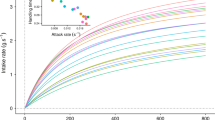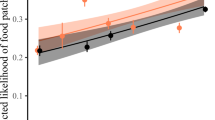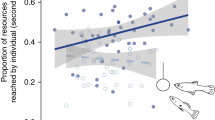Abstract
In socially foraging animals, it is widely acknowledged that the position of an individual within the dominance hierarchy of the group has a large effect upon its foraging behaviour and energetic intake, where the intake of subordinates can be reduced through socially mediated interference. In this paper, we explore the effects of interference upon group dynamics and individual behaviour, using a spatially explicit individual-based model. Each individual follows a simple behavioural rule based upon its energetic reserves and the actions of its neighbours (where the rule is derived from game theory models). We show that dominant individuals should have larger energetic reserves than their subordinates, and the size of this difference increases when either food is scarce, the intensity of interference suffered by the subordinates increases, or the distance over which dominant individuals affect subordinates increases. Unlike previous models, the results presented in this paper about differences in reserves are not based upon prior assumptions of the effects of social hierarchy and energetic reserves upon predation risk, and emerge through nothing more than a reduction in energetic intake by the subordinates when dominants are present. Furthermore, we show that increasing interference intensity, food availability or the distance over which dominants have an effect also causes the difference in movement between ranks to increase (where subordinates move more than dominants), and the distance over which dominants have an effect changes the size of the groups that the different ranks are found in. These results are discussed in relation to previous studies of intra- and interspecific dominance hierarchies.




Similar content being viewed by others
References
Anderson MJ (2001) Permutation tests for univariate or multivariate analysis of variance and regression. Can J Fish Aquat Sci 58:626–639
Barrett GM, Shimizu K, Bardi M, Asaba S, Mori A (2002) Endocrine correlates of rank, reproduction, and female-directed aggression in male Japanese macaques (Macaca fuscata). Horm Behav 42:85–96
Barta Z, Giraldeau L-A (1998) The effect of dominance hierarchy on the use of alternative foraging tactics: a phenotype-limited producing-scrounging game. Behav Ecol Sociobiol 42:217–223
Bercovitch FB, Ziegler TE (2002) Current topics in primate socioendocrinology. Annu Rev Anthropol 31:45-67
Bicca-Marques JC, Garber PA (2003) Experimental field study of the relative costs and benefits to wild tamarins (Saguinus imperator and S. fuscicollis) of exploiting contestable food patches as single- and mixed-species troops. Am J Primatol 60:139–153
Black JM, Owen M (1989) Agonistic behaviour in barnacle goose flocks: assessment, investment and reproductive success. Anim Behav 37:199–209
Black JM, Carbone C, Wells RL, Owen M (1992) Foraging dynamics in goose flocks—the cost of living on the edge. Anim Behav 44:41–50
Bryant DM, Newton AV (1994) Metabolic costs of dominance in dippers, Cinclus cinclus. Anim Behav 48:447–455
Buchanan KL (2000) Stress and the evolution of condition-dependent signals. Trends Ecol Evol 15:156–160
Camazine S, Deneubourg J-L, Franks NR, Sneyd J, Theraulaz G, Bonabeau E (2001) Self-organization in biological systems. Princeton University Press, Princeton
Caraco T, Barkan C, Beacham JL, Brisbin L, Lima S, Mohan A, Newman JA, Webb W, Withiam ML (1989) Dominance and social foraging: a laboratory study. Anim Behav 38:41–58
Clark CW, Ekman J (1995) Dominant and subordinate fattening strategies: a dynamic game. Oikos 72:205–212
Clark CW, Mangel M (2000) Dynamic state variable models in ecology: methods and applications. Oxford University Press, New York
Conradt L (1998) Could asynchrony in activity between the sexes cause intersexual social segregation in ruminants? Proc R Soc Lond B 265:1359–1363
Couzin ID, Krause J (2003) Self-organization and collective behavior in vertebrates. Adv Study Behav 32:1–75
Crawley MJ (2002) Statistical computing: an introduction to data analysis using S-Plus. Wiley, Chichester
Cuthill IC, Houston AI (1997) Managing time and energy. In: Krebs JR, Davies NB (eds) Behavioural ecology: an evolutionary approach, 4th edn. Blackwell Science, Oxford, pp 97–120
Dall SRX, Houston AI, McNamara JM (2004) The behavioural ecology of personality: consistent individual differences from an adaptive perspective. Ecol Lett 7:734–739
Datta SB (1992) Effects of availability of allies on female dominance structure. In: Harcourt AH (ed) Coalitions and alliances in humans and other animals. Oxford University Press, Oxford
Dugatkin LA (2001) Bystander effects and the structure of dominance hierarchies. Behav Ecol 12:348–352
Dugatkin LA, Earley RL (2003) Group fusion: the impact of winner, loser, and bystander effects on hierarchy formation in large groups. Behav Ecol 14:367–373
Dunbar RIM (1992) Time—a hidden constraint on the behavioural ecology of baboons. Behav Ecol Sociobiol 31:35–49
Ekman J (1987) Exposure and time use in willow tit flocks: the cost of subordination. Anim Behav 35:445–452
Ekman J (2004) Mass-dependence in the predation risk of unequal competitors; some models. Oikos 105:109–116
Ens BJ, Goss-Custard JD (1984) Interference among oystercatchers, Haematopus ostralegus, feeding on mussels, Mytilus edulis, on the Exe Estuary. J Anim Ecol 53:217–231
Giraldeau L-A, Caraco T (2000) Social foraging theory. Princeton University Press, Princeton
Goss-Custard JD (1980) Competition for food and interference among waders. Ardea 68:31–52
Goss-Custard JD, Caldow RWG, Clarke RT, Durell SEAV, Sutherland WJ (1995a) Deriving population parameters from individual variations in foraging behaviour. I. Empirical game theory distribution model of oystercatchers Haematopus ostralegus feeding on mussels Mytilus edulis. J Anim Ecol 64:265–276
Goss-Custard JD, Caldow RWG, Clarke RT, West AD (1995b) Deriving population parameters from individual variations in foraging behaviour. II. Model tests and population parameters. J Anim Ecol 64:277–289
Hamilton WD (1971) Geometry for the selfish herd. J Theor Biol 31:295–311
Hay JM, Evans PR, Ward RM, Hamer KC (2004) Poor nutritional status as a consequence of high dominance status in the coal tit Parus ater. Ibis 146:103–107
Hemelrijk CK (1999) An individual-orientated model of the emergence of despotic and egalitarian societies. Proc R Soc Lond B 266:361–369
Hemelrijk CK (2000) Towards the integration of social dominance and spatial structure. Anim Behav 59:1035–1048
Hemelrijk CK (2002a) Self-organizing properties of primate social behavior: a hypothesis for intersexual rank overlap in chimpanzees and bonobos. Evol Anthropol 1:91–94 (Suppl)
Hemelrijk CK (2002b) Understanding social behaviour with the help of complexity science. Ethology 108:655–671
Hogstad O (1987) It is expensive to be dominant. Auk 104:333–336
Houston AI, McNamara JM (1999) Models of adaptive behaviour: an approach based on state. Cambridge University Press, Cambridge
Houston AI, McNamara JM, Hutchinson JMC (1993) General results concerning the trade-off between gaining energy and avoiding predation. Phil Trans R Soc Lond B 341:375–397
Ihobe H (1989) How social relationships influence a monkey’s choice of feeding sites in the troop of Japanese macaques (Macaca fuscata fuscata). Primates 30:17–25
Isbell LA, Pruetz JD, Lewis M, Young TP (1999) Rank differences in ecological behavior: a comparative study of patas monkeys (Erythrocebus patas) and vervets (Cercopithecus aethiops). Int J Primatol 20:257–272
Krause J, Ruxton GD (2002) Living in groups. Oxford University Press, Oxford
Lundborg K, Brodin A (2003) The effect of dominance rank on fat deposition and food hoarding in the willow tit Parus montanus—an experimental test. Ibis 145:78–82
Martin JE, Edwards SA (1994) Feeding behaviour of outdoor sows: the effects of diet quantity and type. Appl Anim Behav Sci 41:63–74
Metcalfe NB, Taylor AC, Thorpe JE (1995) Metabolic rate, social status and life history strategies in Atlantic salmon. Anim Behav 49:431–436
Millikan GC, Gaddis P, Pulliam HR (1985) Interspecific dominance and the foraging behaviour of juncos. Anim Behav 33:428–435
Muller MN, Wrangham RW (2004) Dominance, cortisol and stress in wild chimpanzees (Pan troglodytes schweinfurthii). Behav Ecol Sociobiol 55:332–340
Murton RK, Isaacson AJ, Westwood NJ (1966) The relationships between wood-pigeons and the clover food supply and the mechanism of population control. J Appl Ecol 3:55–93
Murton RK, Isaacson AJ, Westwood NJ (1971) The significance of gregarious feeding behaviour and adrenal stress in a population of wood-pigeons Columba palumbus. J Zool (Lond) 165:53–84
Nakano S (1995) Individual differences in resource use, growth and emigration under the influence of a dominance hierarchy in fluvial red-spotted masu salmon in a natural habitat. J Anim Ecol 64:75–84
Paz-y-Miño CG, Bond AB, Kamil AC, Balda RP (2004) Pinyon jays use transitive interference to predict social dominance. Nature 430:778–781
Peake TM, McGregor PK (2004) Information and aggression in fish. Learn Behav 32:114–121
Peake TM, Terry AMR, McGregor PK, Dabelsteen T (2002) Do great tits assess rivals by combining direct experience with information gathered by eavesdropping? Proc R Soc Lond B 269:1925–1929
Pettifor RA, Caldow RWG, Rowcliffe JM, Goss-Custard JD, Black JM, Hodder KH, Houston AI, Lang A, Webb J (2000) Spatially explicit, individual-based, behavioural models of the annual cycle of two migratory goose populations. J Appl Ecol (Suppl 1)37:103–135
R Development Core Team (2004) R: a language and environment for statistical computing. R Foundation for Statistical Computing, Vienna
Rands SA, Cowlishaw G, Pettifor RA, Rowcliffe JM, Johnstone RA (2003) The spontaneous emergence of leaders and followers in a foraging pair. Nature 423:432–434
Rands SA, Pettifor RA, Rowcliffe JM, Cowlishaw G (2004) State-dependent foraging rules for social animals in selfish herds. Proc R Soc Lond B 271:2613–2620
Røskaft E, Järvi T, Bakken M, Bech C, Reinertsen RE (1986) The relationship between social status and resting metabolic rate in great tits (Parus major) and pied flycatchers (Ficedula hypoleuca). Anim Behav 34:838–842
Rowcliffe JM, Pettifor RA, Carbone C (2004) Foraging inequalities in large groups: quantifying depletion experienced by individuals in goose flocks. J Anim Ecol 73:97–108
Ruckstuhl KE (1998) Foraging behaviour and sexual segregation in bighorn sheep. Anim Behav 56:99–106
Ruckstuhl KE, Neuhaus P (2002) Sexual segregation in ungulates: a comparative test of three hypotheses. Biol Rev 77:77–96
Saito C (1996) Dominance and feeding success in female Japanese macaques, Macaca fuscata: effects of food patch size and inter-patch distance. Anim Behav 51:967–980
Schneider KJ (1984) Dominance, predation, and optimal foraging in white-throated sparrow flocks. Ecology 65:1820–1827
Senar JC, Polo V, Uribe F, Camerino M (2000) Status signalling, metabolic rate and body mass in the siskin: the cost of being a subordinate. Anim Behav 59:103–110
Stephens DW, Krebs JR (1986) Foraging theory. Princeton University Press, Princeton
Stillman RA, Goss-Custard JD, Clarke RT, Durell SEAV (1996) Shape of the interference function in a foraging vertebrate. J Anim Ecol 65:813–824
Stillman RA, Goss-Custard JD, Caldow RWG (1997) Modelling interference from basic foraging behaviour. J Anim Ecol 66:692–703
Stillman RA, Caldow RW, Goss-Custard JD, Alexander MJ (2000) Individual variation in intake rate: the relative importance of foraging efficiency and dominance. J Anim Ecol 69:484–493
Stillman RA, Bautista LM, Alonso JC, Alonso JA (2002) Modelling state-dependent interference in common cranes. J Anim Ecol 71:874–882
Van Gils JA, Piersma T (2004) Digestively constrained predators evade the cost of interference competition. J Anim Ecol 73:386–398
Verhulst S, Hogstad O (1996) Social dominance and energy reserves in flocks of willow tits. J Avian Biol 27:203–208
Vézina F, Thomas DW (2000) Social status does not affect resting metabolic rate in wintering dark-eyed junco (Junco hyemalis). Physiol Biochem Zool 73:231–236
Waite TA (1987) Dominance-specific vigilance in the tufted titmouse: effects of social context. Condor 89:932–935
Wilensky U (1999) NetLogo [online: http://ccl.northwestern.edu/netlogo/]. Center for Connected Learning and Computer-based Modeling, Northwestern University, Evanston
Witter MS, Cuthill IC (1993) The ecological costs of avian fat storage. Phil Trans R Soc Lond B 340:73–92
Acknowledgements
This work was supported by a Natural Environment Research Council research grant awarded to GC, RAP, JMR and Rufus Johnstone (University of Cambridge). GC is currently funded by a NERC Advanced Fellowship. SAR created the model in discussion with GC. SAR coded the simulations, conducted the statistical analysis, and was responsible for the initial draft of the manuscript. The authors thank Fredi Devas, Kavita Isvaran, Rufus Johnstone, Hanna Kokko, Ryan Earley and an anonymous referee for valuable discussion and comments.
Author information
Authors and Affiliations
Corresponding author
Additional information
Communicated by: H. Kokko
Rights and permissions
About this article
Cite this article
Rands, S.A., Pettifor, R.A., Rowcliffe, J.M. et al. Social foraging and dominance relationships: the effects of socially mediated interference. Behav Ecol Sociobiol 60, 572–581 (2006). https://doi.org/10.1007/s00265-006-0202-4
Received:
Revised:
Accepted:
Published:
Issue Date:
DOI: https://doi.org/10.1007/s00265-006-0202-4




